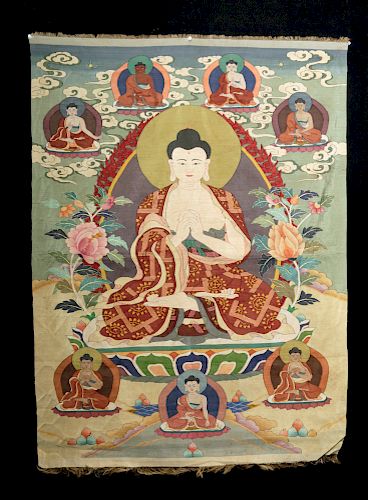19th C. Chinese Silk Kesi-Stitch Thangka - Sakyamuni
Lot 103
About Seller
Artemis Fine Arts
686 S Taylor Ave, Ste 106
Louisville, CO 80027
United States
Selling antiquities, ancient and ethnographic art online since 1993, Artemis Gallery specializes in Classical Antiquities (Egyptian, Greek, Roman, Near Eastern), Asian, Pre-Columbian, African / Tribal / Oceanographic art. Our extensive inventory includes pottery, stone, metal, wood, glass and textil...Read more
Estimate:
$5,000 - $6,000
Absentee vs Live bid
Two ways to bid:
- Leave a max absentee bid and the platform will bid on your behalf up to your maximum bid during the live auction.
- Bid live during the auction and your bids will be submitted real-time to the auctioneer.
Bid Increments
| Price | Bid Increment |
|---|---|
| $0 | $25 |
| $300 | $50 |
| $1,000 | $100 |
| $2,000 | $250 |
| $5,000 | $500 |
| $10,000 | $1,000 |
| $20,000 | $2,500 |
| $50,000 | $5,000 |
| $100,000 | $10,000 |
| $200,000 | $20,000 |
About Auction
By Artemis Fine Arts
May 10, 2018
Set Reminder
2018-05-10 10:00:00
2018-05-10 10:00:00
America/New_York
Bidsquare
Bidsquare : Fine Ethnographic / Asian / Ancient Art
https://www.bidsquare.com/auctions/artemis-gallery/fine-ethnographic-asian-ancient-art-3213
Featuring antiquities from around the world including Pre-Columbian, Tribal, Classical, Asian, so much more! Artemis Fine Arts info@artemisfinearts.com
Featuring antiquities from around the world including Pre-Columbian, Tribal, Classical, Asian, so much more! Artemis Fine Arts info@artemisfinearts.com
- Lot Description
East Asia, China, ca. 19th century CE. A fine kesi slit tapestry silk thangka depicting Sakyamuni (also Shakyamuni) Buddha sitting upon a lotus pad. His hands make the mudra gesture of supreme enlightnment - uttarabodhi. He is surrounded by a flaming nimbus and seven different buddhas. Noteworthy are the very fine lines made of gold-wrapped silk threads that are woven into the tapestry as contour lines for the ornate patterns of Sakyamuni's robes, and also for the leaves of the flowers. Size: 39" L x 27.75" W (99.1 cm x 70.5 cm)
Shakyamuni Buddha also known as Gautama Buddha (Siddhartha Gautama) was born in 563 BC at Lumbini in the western part of Nepal. He attained "Bodhi Gyana" enlightenment - a state of Nirvana - after six years of meditation, and was then called the enlightened one "Buddha". Shakyamuni died at the age of eighty at Kusinagara. To distinguish from all other Buddha, he is called Shakyamuni (The lion of Shakya clan), the son of king Suddhodana and queen Mayadevi. Imagery of the Shakyamuni Buddha is believed to bring peace and enlightenment in the body and the mind. Seven other Buddhas sprouting from lotuses surround Sakyamuni. This is such a rich metaphor as the Buddha, like a lotus, is determined to grow out of the muddy waters surroundings to achieve Nirvana, that is the defilements and sufferings of life.
Kesi is a hand-made woven loom technique, oftentimes used to create Imperial summer robes. As opposed to continuous weft brocade, in Kesi weaving, each color area is woven from a separate bobbin, the horizontal weft is then linked to the next colored bobbin thread, and the weaving is continued. The links are evenly distributed along the mutual border of two different areas of color on a 45 degree angle. However, the closer to vertical the art lines get, the further apart the links between colors become. Thus, due to the nature of the technique, the tapestry displays vertical 'slits' (kesi-slit tapestry). This use of many bobbins for each different colored area of the thangka makes the weaving process both technically demanding and extremely time-consuming. A kesi thangka might easily require more than a year to create. The tapestry is completely two-dimensional, and a wonderful outcome of this technique is that the back side of a kesi is exactly the same as the front (only in reverse).
K'o-ssu or kesi is a technique in Chinese silk tapestry, admired for its lightness and clarity of pattern. K'o-ssu first appeared during the Tang Dynasty (618–907), and became popular in the Southern Song Dynasty (1127–1279), reaching its height during the Ming dynasty (1368–1644). The style continued to be popular until the early 20th century, and the end of the Qing Dynasty in 1911–12.
Provenance: private Bricker collection
All items legal to buy/sell under U.S. Statute covering cultural patrimony Code 2600, CHAPTER 14, and are guaranteed to be as described or your money back.
A Certificate of Authenticity will accompany all winning bids.
We ship worldwide and handle all shipping in-house for your convenience.
#124142Areas of slight discoloration commensurate with age. Otherwise excellent.Condition
- Shipping Info
-
All shipping is handled in-house for your convenience. Your invoice from Artemis Gallery will include shipping calculation instructions. If in doubt, please inquire BEFORE bidding for estimated shipping costs for individual items.
-
- Buyer's Premium



 EUR
EUR CAD
CAD AUD
AUD GBP
GBP MXN
MXN HKD
HKD CNY
CNY MYR
MYR SEK
SEK SGD
SGD CHF
CHF THB
THB
















